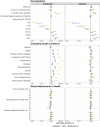Predictors of all-cause mortality among patients hospitalized with influenza, respiratory syncytial virus, or SARS-CoV-2
- PMID: 35611399
- PMCID: PMC9347457
- DOI: 10.1111/irv.13004
Predictors of all-cause mortality among patients hospitalized with influenza, respiratory syncytial virus, or SARS-CoV-2
Abstract
Background: Shared and divergent predictors of clinical severity across respiratory viruses may support clinical and community responses in the context of a novel respiratory pathogen.
Methods: We conducted a retrospective cohort study to identify predictors of 30-day all-cause mortality following hospitalization with influenza (N = 45,749; 2010-09 to 2019-05), respiratory syncytial virus (RSV; N = 24 345; 2010-09 to 2019-04), or severe acute respiratory syndrome coronavirus 2 (SARS-CoV-2; N = 8988; 2020-03 to 2020-12; pre-vaccine) using population-based health administrative data from Ontario, Canada. Multivariable modified Poisson regression was used to assess associations between potential predictors and mortality. We compared the direction, magnitude, and confidence intervals of risk ratios to identify shared and divergent predictors of mortality.
Results: A total of 3186 (7.0%), 697 (2.9%), and 1880 (20.9%) patients died within 30 days of hospital admission with influenza, RSV, and SARS-CoV-2, respectively. Shared predictors of increased mortality included older age, male sex, residence in a long-term care home, and chronic kidney disease. Positive associations between age and mortality were largest for patients with SARS-CoV-2. Few comorbidities were associated with mortality among patients with SARS-CoV-2 as compared with those with influenza or RSV.
Conclusions: Our findings may help identify patients at greatest risk of illness secondary to a respiratory virus, anticipate hospital resource needs, and prioritize local prevention and therapeutic strategies to communities with higher prevalence of risk factors.
Keywords: SARS-CoV-2; hospitalization; influenza; mortality; respiratory syncytial virus.
© 2022 The Authors. Influenza and Other Respiratory Viruses published by John Wiley & Sons Ltd.
Conflict of interest statement
The authors declare no competing interests that are relevant to the content of this article.
Figures


Similar articles
-
A Narrative Review of Key Risk Factors for Severe Illness Following SARS-CoV-2, Influenza Virus, and Respiratory Syncytial Virus Infection.Infect Dis Ther. 2025 Jan;14(Suppl 1):39-61. doi: 10.1007/s40121-024-01081-3. Epub 2024 Dec 30. Infect Dis Ther. 2025. PMID: 39739198 Free PMC article. Review.
-
Clinical and epidemiological characteristics of respiratory syncytial virus, SARS-CoV-2 and influenza paediatric viral respiratory infections in southwest Saudi Arabia.Ann Med. 2025 Dec;57(1):2445791. doi: 10.1080/07853890.2024.2445791. Epub 2024 Dec 24. Ann Med. 2025. PMID: 39717000 Free PMC article.
-
Severity of respiratory syncytial virus compared with SARS-CoV-2 and influenza among hospitalised adults ≥65 years.J Infect. 2024 Nov;89(5):106292. doi: 10.1016/j.jinf.2024.106292. Epub 2024 Sep 26. J Infect. 2024. PMID: 39341402
-
Outcomes of SARS-CoV-2 Omicron Variant Infections Compared With Seasonal Influenza and Respiratory Syncytial Virus Infections in Adults Attending the Emergency Department: A Multicenter Cohort Study.Clin Infect Dis. 2024 Apr 10;78(4):900-907. doi: 10.1093/cid/ciad660. Clin Infect Dis. 2024. PMID: 37883521 Free PMC article.
-
The role of respiratory co-infection with influenza or respiratory syncytial virus in the clinical severity of COVID-19 patients: A systematic review and meta-analysis.J Glob Health. 2022 Sep 17;12:05040. doi: 10.7189/jogh.12.05040. J Glob Health. 2022. PMID: 36112521 Free PMC article.
Cited by
-
Characteristics and outcomes of patients hospitalized for infection with Influenza A, SARS-CoV-2 or respiratory syncytial virus in the season 2023/2024 in a large German primary care centre.Eur J Med Res. 2024 Oct 22;29(1):509. doi: 10.1186/s40001-024-02096-9. Eur J Med Res. 2024. PMID: 39439011 Free PMC article.
-
A Narrative Review of Key Risk Factors for Severe Illness Following SARS-CoV-2, Influenza Virus, and Respiratory Syncytial Virus Infection.Infect Dis Ther. 2025 Jan;14(Suppl 1):39-61. doi: 10.1007/s40121-024-01081-3. Epub 2024 Dec 30. Infect Dis Ther. 2025. PMID: 39739198 Free PMC article. Review.
-
Comparative analysis of mortality in patients admitted with an infection with influenza A/B virus, respiratory syncytial virus, rhinovirus, metapneumovirus or SARS-CoV-2.Influenza Other Respir Viruses. 2024 Jan 18;18(1):e13237. doi: 10.1111/irv.13237. eCollection 2024 Jan. Influenza Other Respir Viruses. 2024. PMID: 38249443 Free PMC article.
-
Optimal Timing of Vaccination: A Narrative Review of Integrating Strategies for COVID-19, Influenza, and Respiratory Syncytial Virus.Infect Dis Ther. 2025 May;14(5):911-932. doi: 10.1007/s40121-025-01135-0. Epub 2025 Apr 10. Infect Dis Ther. 2025. PMID: 40205144 Free PMC article. Review.
-
Preventing respiratory syncytial virus in older adults.Can Fam Physician. 2024 Apr;70(4):258. doi: 10.46747/cfp.7004258. Can Fam Physician. 2024. PMID: 38627002 Free PMC article. No abstract available.
References
Publication types
MeSH terms
Grants and funding
LinkOut - more resources
Full Text Sources
Medical
Miscellaneous

